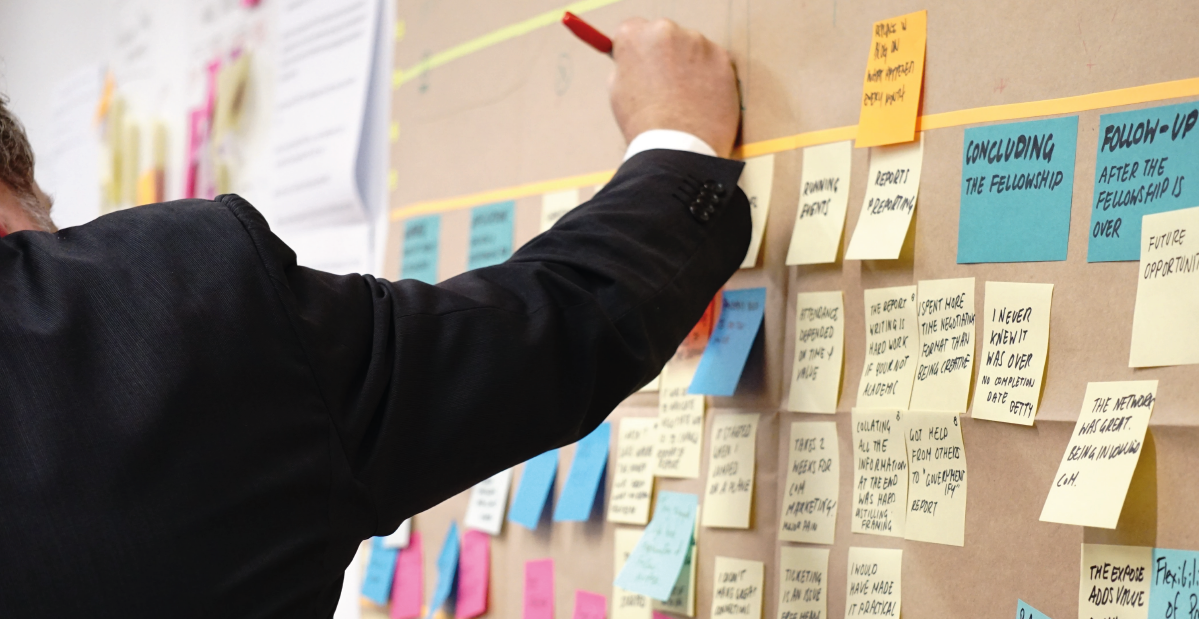-
TrendsEuropean Affairs
-
CountriesGlobalSpain
“The first thing we decided was that ‘it won’t just be a giant Zoom meeting,’” producer Ricky Kirshner explained to Variety magazine when they asked him about the challenge the Democratic Party had presented to him and his partner, Glenn Weiss: To organize the first ever party convention using an entirely virtual format.
It is easy to imagine the pressure these experienced producers (who were responsible for the 2019 Tony Awards Ceremony) were under at the time. In such a hotly contested presidential campaign, Joe Biden’s team needed an event that would surprise, excite and involve the voter base, as well as those on the fence and even some conservative voters. The formulas for party conventions had remained unchanged for decades in both U.S. political culture and in most democracies. Although they were designed to be communicated via the mass media and ultimately via social media, their magic historically lay in the chemistry between the speakers and the thousands of delegates and supporters gathered at the venue. Everything else, including the production of the show itself, has typically been aimed at amplifying that magic and bringing it to all corners of the country.
Sadoux Kim and Chuck LaBella, who answered the Republican Party’s challenge, also had a tough task ahead of them. In their case, the people behind “The Apprentice,” the TV gameshow that popularized Donald Trump, were asked to organize the event like a vibrant and spectacular television show despite the fact that the speakers would be surrounded by fewer people.
Results aside, both teams did extraordinary jobs in terms of the unprecedented and unparalleled nature of the task. Both understood the need to all but start from scratch to get it done, and both needed to combine knowledge and planning with improvisation, given the lack of precedents on this scale.
AT COMPANIES
Millions of business leaders around the world put their businesses on the line every day at critical meetings. They have risen to where they stand today by preparing themselves and their organizations to persuade an employee, client, investor, regulator or partner during negotiations, which either prosper or fall by the wayside. From handshake style to clothing choice, from using multimedia resources to controlling nonverbal communication, this preparation has always taken place within a context where those relationships would eventually be forged face-to-face.
The world of business has always quickly adapted itself to consider every remote communication tool an important accessory to the sustainability of brands, products and service globalization. However, it has always made enormous efforts just so that each vital contact, on which the future of a specific project might depend, can take place face-to-face when the time comes.
THEN THE PANDEMIC ARRIVED
Entrepreneurs had to accept that the final push to sell their proposal would have to take place via screen; investors had to acknowledge that knowledge about the leaders providing an opportunity and the subsequent negotiations would now take place entirely remotely; CEOs had to make their peace with holding talks with authorities to decide on key business regulations via video call; marketing and sales directors had to accept that the product launch event they had planned would have to take place on a virtual stage. The same thing happened with team collaboration, the hiring and management of essential talent, acquisitions, customer services and, in general, every critical business process in which interpersonal relationships are fundamental.
We were all forced to move from using technology in a supporting role to using it exclusive in record time. Through a joint effort (and surprisingly “easily”), we managed to ensure that initiatives did not stop in their tracks simply because we were unable to see each other face-to-face.
“Entrepreneurs had to accept that the final push to sell their proposal would have to take place via screen; investors had to acknowledge that knowledge about the leaders providing an opportunity and the subsequent negotiations would now take place entirely remotely”


CLEAR ADVANTAGES
During this process, we have seen certain elements, such as investment roadshows or company investment selection processes, benefit from significant positive factors. The positives most commonly cited by consultants, investment funds and investor relations directors involve the costly travel arrangements and increased organizational complexity these types of activities had called for in the past. These trips often led to the loss of highly valuable time for the most senior teams, as well as an impact on organizations’ daily operations.
Something similar is happening with company board meetings. Virtual formats have brought advantages to the table beyond the savings obtained from reduced travel expenses. The main advantages CEOs and board members highlighted refer to meeting design (a more executive format with shorter agendas), the incorporation of prior debates on digital platforms, a greater use of cloud-based documents, the ease with which external guests can be invited to meetings and the possibilities today’s technology offers for dividing meetings into smaller debate groups at any time. This even includes one-on-one discussions, and these easy breakout groups can contribute to richer, more in-depth debates, as well as build trust between board members.
Even in company conferences, one of the business practices most heavily impacted by the restrictions, advantages can be seen in the switch to virtual models. During the pandemic, numerous meetings have committed to virtual reality technologies, leading to excellent results. A perfect example of this is the “Laval Virtual World,” an annual meeting for the AR/VR industry. For the 2020 edition of this event, held in April, 11,000 attendees took part, 150 conferences were held, dozens of parallel meetings were organized and contact in the virtual medium was promoted among thousands of professionals. Again, the foreseeable cost reduction for organizers and attendees was boosted by other advantages stemming from this format’s flexibility, including more networking time and fluid conversation dynamics during the talks, which were supported by chat platforms, discussion forums and online collaborative work tools.
AND SOME NEGATIVE IMPACTS WE MUST CORRECT
Engaging in a debate by videoconference or giving a talk at a webinar is exhausting. We already knew that because we have been doing it for years whenever circumstances have required. Nonetheless, we have now seen that shifting all interactions to this medium is tiring.
We also knew these long-distance communication formulas were unsuitable for certain decision and co-creation processes. Being forced to rest the entire weight of our activity on these techniques has led to frustration, often simply due to the fact that this was supposed to be only a temporary requirement, that has been shelved away.
Our teams and everyone on which our projects depend (our stakeholders) feel the effects of both the positive and negative, and by extension, so do our businesses. The ongoing use of these practices due to the pandemic’s persistence and our collective desire to harness technology’s advantages both pose major challenges. Exhaustion and frustration can undermine the health of relationships, challenge organizational cultures and threaten the critical company processes that involve socialization and trust.
“Even in company conferences, one of the business practices most heavily impacted by the restrictions, advantages can be seen in the switch to virtual models. During the pandemic, numerous meetings have committed to virtual reality technologies, leading to excellent results”

THE LESSON TO BE LEARNED FROM THE DEMOCRATIC AND REPUBLICAN CONVENTIONS
Now that this new normal is here to stay, redesigning our approach to all such meetings should be added to the discussions surrounding the turning point. Our long-term solution cannot simply be to copy what we used to do at face-to-face meetings in the virtual world.
CULTURAL AND ORGANIZATIONAL
This is no small challenge. Rethinking is easy; relearning is a devilishly tricky task. Introducing a new process or tool requires enormous effort from any organization. Resistance to change, which we have thousands of pages dedicated to seeking a solution for, continues to surprise with its ongoing persistence. Forgetting a routine we had settled into requires questioning the principles on which it is based, and human beings need a long time to deal with that.
But time is the one thing we simply do not have. We did not have it before this crisis hit, we did not have it while dealing with it in its early stages and we will not have it as we address the overriding need to resolve the situation.
Hence, cultural issues represent one facet of the problem. Companies that have understood this are rolling out programs to train their professionals, starting with minor changes that will lead to sizeable positive impacts.
TECHNOLOGICAL
Alongside this, technology has made things both easier and more difficult. We already had the tools, though most of them lacked what they needed to put them at the heart of the business world’s interpersonal relationships.
Providers have reacted with dizzying speed, embarking on a race to improve their services. They have produced an arsenal of new functionalities from their labs; renewed their admin features, operational approaches, usability and interconnection features; and encouraged their partners to innovate based on their products’ core features. The following have been among the most highly sought-after and actively used technologies during the pandemic:
- VR/AR platforms. The expectations placed upon them and their use have changed due to the need to recreate a multitude of scenarios, ranging from events and exhibitions to concept testing and co-creation workshops, etc. We now have new virtual reality spaces and interactive content, as well as connectivity with other virtual platforms and collaborative work environments.
- The most relevant groups in the market have launched new types of videoconferences designed to fill a number of needs. For one, they work to make interaction easier by providing options for speaker turn management, prior content preparation, debate facilitation, splitting participants into groups, separate meetings, one-on-one communication options and translation/transcription systems. They have also developed tools to better share content (using different screen formats and better integrating multimedia content), manage deliberation dynamics (through vote management, commentary and parallel groups) and quickly manage video and sound through mute and camera shortcuts. These groups have also worked to create tools that improve explanations and the “look & feel” of meetings, including virtual boards, post-its, mind maps, backgrounds and more, as well as integrate virtual conferences with the collaborative work tool universe (links to the cloud).
- This virtual meeting format has renovated participation dynamics, speaker management features, multimedia system connectivity, simulation and training support incorporation and groupware and CRM integration during the course of the pandemic. It has also worked to provide parallel forums and rooms; coexist with different browsers, audio and video apps and hardware; manage and track guests and attendees; and options to personalize features, ranging from backgrounds to the menu items available to organizers, speakers and participants.
- Collaboration and knowledge and project management. Just like with videoconferencing and webinar platforms, these efforts have included instant messaging and collaboration features focused on making teamwork easier by doing what they are designed for – incorporating communication options via video and other media.
- Presentation services. Alternatives to classic slideshows are also offering new options, designed for remote use. They are strengthening their features to display graphics and videos more easily, encouraging integration with other collaborative tools and rolling out dialogue functionalities around the presentation content.
- Deliberation platforms. Based on the need to simplify and implement decision-making at meetings, many of these services now offer modules that integrate with the abovementioned systems to facilitate idea and opinion collection and find ways participants can prepare, evaluate and even vote on possible alternatives. This represents an excellent addition to the other models.
“Technology has made things both easier and more difficult. We already had the tools, though most of them lacked what they needed to put them at the heart of the business world’s interpersonal relationships”

However, by focusing on these technologies, providers have not prioritized many of the technologies we need to help make remote communications less exhausting and frustrating. This is to be expected. They have not had time either. What we needed was greater collaboration between mathematicians, IT specialists, designers, communicators and users to intelligently decide the order of priorities for those new features, as well as determine how to implement them for everyone.
This was exacerbated by the fact that the pandemic has clearly highlighted the current flaws in the networks, security and hardware devices we have in our homes, as well as the rigidity of many corporate systems, which has prevented the interoperability of these tools. It has also revealed a lack of knowledge and skills among users, which prevents them from tackling even the smallest challenges that come with using IT systems.
This means there is a technological facet to the problem that cannot be avoided.
Attempting to tackle these cultural and technological facts separately makes no sense at all. Neither does it make sense to tackle them together under a single megaproject.
Organizations must find a middle ground that will help us rapidly improve without holding us back. Multidisciplinary collaboration is an essential part of this solution.
For progress
Many opinion leaders have agreed that the pandemic has led to unprecedented progress in the use and rollout of interpersonal relationship technologies. Most professionals have been surprised by the relative ease with which virtual routines have been developed, especially as organizations used to put up enormous resistance to these ideas. Furthermore, we have all seen the interesting advantages that have resulted from doing so: Time and cost savings; greater transversality within teams; accessibility to stakeholders that otherwise seemed out of reach; and a cultural change that fosters collaboration, process traceability and, strangely, trust.
These results seem to confirm that many of these new routines, which have been taken up en masse (and not only by early adopters), are here to stay. With that in mind, efforts should continue along these lines:
- Identify the contact points we maintain with our stakeholders.
- Establish the common elements in the experiences we want to offer our stakeholders.
- Systemize the review of technologies that best suit our objectives in order to monitor their constant update process.
- Define the essential skills and abilities needed by our team so interpersonal communications can be as effective as possible, as we all need it to be.
- Map the problems that lead to exhaustion and frustration among users.
- Design and roll out new dynamics and functionalities through pilot projects to experiment with them and measure the positive impacts they have on both the people we are speaking to and our ability to achieve the goals we set ourselves.
- Prepare our organizations to harness those practices, without undervaluing the effort involved in the relearning process.
- Provide ourselves with a set of indicators that encourages us to further develop the dynamics that offer good results and eliminate those that do not bring added value.
If we can understand how much our businesses depend on switching from mere adaptation to anticipation, we will engage in these tasks with a sense of urgency and the correct resources.
Only then will we be able to truly harness all their advantages, minimize their disadvantages and better compete. We will also make a virtue of need, an area where organizations have always been more successful: We will contribute to cultural change according to the times in which we are living, we will reduce the overexertion that improvised adaptation generated, we will reduce anxiety that we have suffered over the revolution in daily operations and we will do it all while strengthening everyone’s confidence in our projects.
Authors
José Luis Rodríguez



